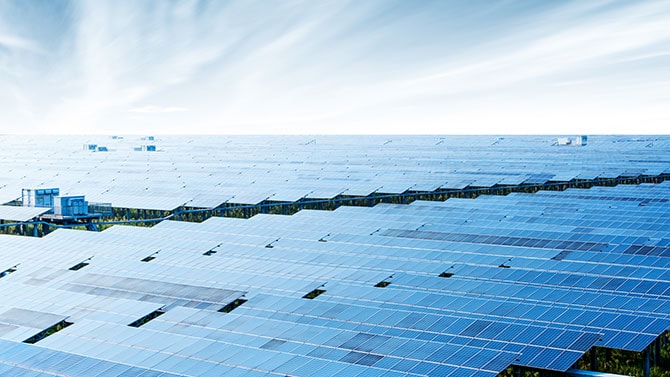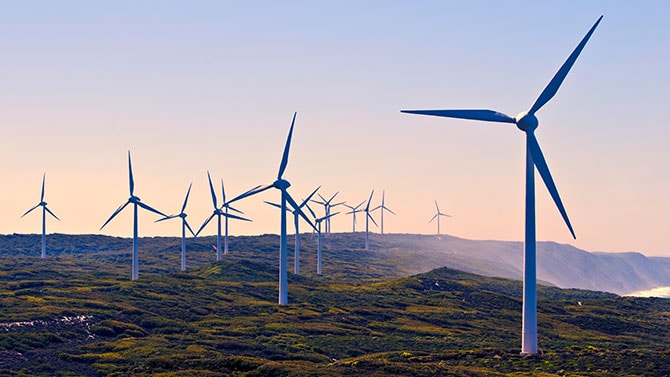Download the report
The supply of critical minerals will make or break the world’s path to net zero. Low-emissions technologies such as solar photovoltaics, wind turbines, batteries for energy storage and magnets for electric vehicles (EVs) rely on critical materials for their production and performance. But as the global energy transition gains momentum, demand for these critical minerals is increasing and shortages are inevitable.
The uneven global distribution of minerals is the outcome of a geological lottery. Through luck, Australia has an abundance of in-demand critical minerals but through good management, we have established a long track record of extracting and delivering minerals reliably. Consequently, we stand to benefit more than most from the emerging opportunities linked to the energy transition.
Australia has long aspired to be more than a ‘dig and ship’ economy that extracts commodities and exports them for processing. The energy transition affords us a once in a generation opportunity to leverage the growing demand for low-emissions technologies and build more value-adding capability on our own shores. This would create a more diverse and resilient economy - one that provides more future-facing jobs, and increases our energy independence in an uncertain geopolitical environment.
“The energy transition affords us a once in a generation opportunity to leverage the growing demand for low-emissions technologies and build more value-adding capability on our own shores.”
But we need to do more than talk about the opportunity. The global scramble to secure critical minerals and supply chains has begun. Given the significance of this opportunity and the pace at which we need to move, there are many stakeholders that have important roles to play. Stakeholders will need to work collaboratively to accelerate the pace and scale at which we develop our critical minerals reserves, and take advantage of supply chain opportunities on offer.
The critical minerals stakeholder ecosystem
Explorers, developers & operators of mining assets are the foundation of energy transition supply chains. Sitting at the heart of the ecosystem, they are the 'constant' in stakeholder interaction.

Policy & Diplomacy
Policy & Diplomacy
Government (including regulatory agencies) can facilitate long term decision-making through appropriate policy making and implementation, streamlining approvals processes, maintaining a stable regulatory environment, and securing partnerships with allied nations to support supply chain development.

Finance
Finance
Traditional financial intermediaries have an important role in financing new mine development and associated infrastructure. Innovative financing structures and the role for other pools of capital will need to be considered, including Original Equipment Manufacturers (OEMs), Superannuation Funds, Impact Funds and Export Credit Agencies (ECAs).

Offtake
Offtake
Off take agreements with credible counterparties are essential to validate projects and de-risk development and project finance. The off taker can be an important source of development capital itself and acting in concert with debt providers and ECAs. Provenance of inputs is an issue for customers, which is making the ability for off takers to have complete visibility of their supply chains a ‘non-negotiable’.

Research
Research
Collaboration between universities and other research and development institutions, and private sector project proponents will be crucial given the technological complexity of minerals processing, the need to extract and process minerals and recycle waste in an environmentally responsible way, the application of technologies and processes to achieve emissions friendly outcomes, and the commercialisation and scaling of new technologies.

Infrastructure
Infrastructure
Infrastructure development will require a range of skill sets to ensure appropriate design and technology choices are made, there is access to sufficient water resources and economic solutions to clean energy (renewables, battery storage) and logistics (road, rail), and social and community infrastructure (including housing) is constructed. Shared or co-development of infrastructure will be a feature in delivering enhanced project economics.

Social licence
Social licence
With the many and varied benefits of increased project activity in regional areas, it is incumbent on project proponents to bring local communities ‘on the journey’ by creating opportunities for engagement, providing a clear articulation of the benefits, and acting in a transparent fashion. An inclusive approach to enable the participation of Indigenous communities and Traditional owners as minority investors in, service providers to, or employees at projects is vital.
Taking urgent action
In this report we explore two main areas where urgent actions are required by stakeholders working together. In taking these urgent actions, we also need to ensure that we are going about it the right way, engaging with communities to deliver on environmental and social expectations.
- Attracting more investment into critical minerals projects and infrastructure
- Creating a policy environment to incentivise growth
- Going about it the right way
Attracting more investment into critical minerals projects and infrastructure
The scale and speed of the global energy transition means we can’t approach financing critical minerals projects and related infrastructure the way it’s previously been done - different approaches are needed.
Creating a policy environment to incentivise growth
Government support can validate and de-risk projects in the eyes of potential investors (especially inbound investors in our experience) - an important step in attracting new pools of capital. This support can be financial, but could also come in the form of accelerating land access, planning approvals and permitting processes, aggregating demand and creating market access by linking Australian critical minerals producers to global supply chains.
Going about it the right way
As we pursue the expansion of our critical minerals industry (both production volumes and onshore supply chain development), it is essential the pursuit is not undertaken at any cost. A balance must be struck between moving quickly and engaging stakeholders through meaningful dialogue to achieve positive social and environmental outcomes.
Attracting more investment into critical minerals projects and infrastructure
The scale and speed of the global energy transition means we can’t approach financing critical minerals projects and related infrastructure the way it’s previously been done - different approaches are needed.
Currently, there is a significant gap between the critical mineral project opportunities and the reality of funding mine development and associated infrastructure.
Critical minerals projects can have high pre-production capital expenditure requirements, sometimes in excess of $1billion before production begins, yet they are often held as single assets by lowly capitalised junior companies. It’s a significant financial outlay that’s required, given opaque markets, volatile mineral pricing and an increasingly uncertain global economic outlook.
It's not just about investing in mining projects. Critical mineral supply chains include processing, refining, purifying, chemicals, manufacturing, recycling and all the enabling infrastructure required to support these activities.
Accessing new sources of capital
There is a role for capital providers beyond traditional sources of mining finance, with opportunities for superannuation and infrastructure funds, governments, international capital, and debt and equity capital markets.
Large superannuation funds have emerged over the past 30 years, and a huge volume of private capital has accumulated over more than a decade of quantitative easing and subdued interest rates. There is an increasing desire for large-scale capital deployment just as a notable shift in investor mentality has occurred, with a growing focus on purpose-driven investing over long-term horizons.
In order to attract more investment, those seeking to develop critical minerals mining operations must improve the way in which they communicate with, and educate, the broader investing market. This will give the market confidence that projects will get developed and generate the cash flows that underpin investment returns.
“To attract more investment, those seeking to develop critical minerals mining operations must improve the way in which they communicate with, and educate, the broader investing market.”
Making the investment case for critical minerals and value-add industries
Investors focused on deploying capital behind the energy transition need to consider the balance of further investments in energy infrastructure (think wind and solar) with an allocation of capital to critical minerals projects and associated supply chain infrastructure.
This balance isn’t driven only by purpose - these assets also offer the possibility of attractive risk-adjusted returns. For example, PwC Australia analysis has identified 30 investment-ready projects spanning lithium, nickel, cobalt, graphite, copper, vanadium and rare earths thatwhich have all completed pre-feasibility studies at a minimum. The average post-tax internal rate of return (IRR) for the pool of projects we analysed was 26%. This compares to PwC analysis of the average IRR for fully merchant (uncontracted) solar and wind development projects in Australia of 9-11%, and 5-8% for fully contracted development projects.
Spreading investment risk through shared infrastructure hubs
There is evidence that adopting a hub framework can deliver synergies and competitive advantage from a concentration of organisations pursuing similar goals. Creating critical mineral hubs (or precincts) would enable collaboration along the supply chain to develop processing and manufacturing facilities, and share financial, operational and innovation risks. Hubs would also provide access to shared infrastructure – roads, rail, water, renewable energy generation, transmission, recycling and import and export facilities. Sharing these costs can result in a material reduction in the pre-production capex burden that falls on any individual organisation.
For example, a shared processing plant that sources its feedstock from multiple miners removes single-asset risk, which can be a barrier to some investors. The processing facility could operate by toll-treating diversified inputs, receiving a set fee for its value added material. This is an investment structure more familiar to traditional infrastructure funds. And processing locally also opens up further investment opportunities in local supply chains, industries and regional communities.
These hubs also provide alternative assets for investors, with enabling infrastructure having the potential to become an asset class in its own right without direct commodity risk exposure. Infrastructure funds could support critical minerals development indirectly by financing renewable energy generation or storage and water solutions rather than the mining assets themselves.
We’re already seeing catalytic government support for critical minerals hubs, with the first in Central West NSW. And in Queensland, the government has committed at least $10million to the Vanadium Common User Facility1 in Townsville with the goal of becoming a leading producer and exporter of new-economy minerals.
Creating a policy environment to incentivise growth
Government support can validate and de-risk projects in the eyes of potential investors (especially inbound investors in our experience) - an important step in attracting new pools of capital. This support can be financial, but could also come in the form of accelerating land access, planning approvals and permitting processes, aggregating demand and creating market access by linking Australian critical minerals producers to global supply chains.
Attracting greater international funding through trade alliances and legislation
Australia’s critical minerals feed global supply chains that underpin the energy transition worldwide, so international funding sources have an important role in building our nation’s capacity. Cultivating Australia’s reputation as the ‘go-to’ global location for critical minerals investment and supply requires bold action on the global stage.
The Quadrilateral Security Dialogue (the Quad) between the US, Australia, India and Japan is a demonstration of how governments can leverage diplomacy to facilitate investment opportunities for Original Equipment Manufacturers (OEMs) and committed buyers of critical minerals. This is a geopolitical strategy to secure supply chains and improve energy security among allied nations. The recently announced billion-dollar Quad investment fund is an example of how such geopolitical cooperation can drive focused investment.
The Quad, coupled with the trilateral security pact between the United States, United Kingdom and Australia (AUKUS), are foundational agreements between Australia and its allies that create opportunities for critical minerals project development and supply chain security. This style of agreement should be the platform for positioning Australia as a valuable partner for those allies looking at friend-shoring2 as a viable way of securing those minerals and supply chains.
There will be an ongoing role for departments and agencies like the Department of Foreign Affairs and Trade; the Department of Climate Change, Energy, the Environment and Water; the Australian Trade and Investment Commission; and the Critical Minerals Office within the Department of Industry, Science and Resources to work with international counterparts around reorienting supply chains and creating demand-supply visibility between jurisdictions.
Australia must also view international investment and offtake through the lens of local value creation and net benefit. We should recognise the increased likelihood of serious disruption to global trade and our energy independence due to the concentration of supply chains in one or a few jurisdictions. We have long supported genuine trade liberalisation - an appropriate position as global trade flourished in the benign geopolitical conditions ushered in by an era of globalisation. Yet, as the dynamics of global trade evolve and the supply of raw materials become a geopolitical lever, there is merit in finding a balance between remaining a paragon of free trade and a reliable supplier of minerals to our allies, and breaking the paradigm of being a ‘dig and ship’ nation.
We can look to Canada as an example of increasing protectionist policy around critical minerals. In October 2022, the Canadian Government introduced a strict framework for evaluating foreign investment by state-owned enterprises in Canadian critical minerals assets.
In Indonesia, the world’s largest producer of nickel, the government is considering some form of cartel for nickel and other critical minerals, modelled on the Organisation of Petroleum Exporting Countries. Indonesia already has a ban on the export of unrefined nickel, forcing the industry to build-out processing capacity onshore.
These examples may be a departure from our free trade mantra, but the importance of these minerals to the global economy, and their impact on our own prosperity means we must strike the right balance.
This is no time for complacency - while these in situ minerals are immovable, the global capital is not. While seeking to work with us, our allies are also pressing ahead with their own plans. The European Union (EU) has announced its intention to introduce a Critical Raw Materials Act3. The objective is to ‘act fast, with ambition, and according to EU values and standards’ to secure lithium and rare earths. The EU is determined to increase EU financial participation in important projects by identifying projects along the supply chain, building strategic reserves and proposing to create the European Sovereignty Fund.
Meanwhile, a suite of US legislation, including the CHIPS & Science Act, the Bipartisan Infrastructure Law and the Inflation Reduction Act is focused on lifting onshore production and processing of critical minerals for EV batteries and defence technologies. The legislation is changing the playing field, and has already benefited a number of Australian companies by way of US grants and other funding.
Uniting Australia’s states and territories on critical minerals strategies
On the domestic front, coordination and collaboration between our states and territories will be essential to creating the most value and sharing the benefits equitably amongst all Australians.
Critical minerals are not the same as bulk commodities. Value-adding activities along critical mineral supply chains are often better suited closer to key infrastructure like power supply and ports than the mineral deposits. This provides a generational opportunity to distribute the benefits of Australia’s mineral wealth more equitably than previous booms, particularly in hubs and precincts in northern Australia.
The Federal Government’s National Battery Strategy4 is a much anticipated playbook for our nation’s battery and battery manufacturing prospects. Tapping into comparative advantages across the states and territories can create national industries in batteries and other low-emissions technologies.
Each region has a role to play but the collective ‘team Australia’ vision needs to be the guiding principle.
Streamlining processes to truncate project lead times
Ease of doing business is a key factor when comparative investment opportunities in different jurisdictions are being analysed.
Lead times for critical minerals projects, from discovery to production, can be in excess of 10 years. To meet demand, we must investigate ways in which these development timelines can be dramatically truncated while maintaining existing standards.
Urgency around energy transition will require governments to reconsider their approach to administering permitting and approvals. A concierge-style service, with one point of contact for companies across government departments is an approach with many positive attributes.
“Coordination and collaboration between our states and territories will be essential to creating the most value and sharing the benefits equitably amongst all Australians.”
Aggregating demand to incentivise local production
The Federal and State Governments in Australia will be among the biggest end-users of low-emissions technologies as they pursue their energy transition and decarbonisation agendas. Their combined buying power will be a vital lever to drive local production and manufacturing decisions and progress Australia’s critical mineral industry beyond mineral extraction.
Linking government policy (say, electrifying a fleet of vehicles) with local manufacturing companies could underwrite investment decisions in local manufacturing. Anecdotal evidence from our work suggests that commitments around demand are more valuable than capital in order to de-risk investment in manufacturing.
Governments can consider local content requirements to catalyse initial investment in local manufacturing. For example, the Future Battery Industries Cooperative Research Centre5 has identified governments’ role as a champion of change in accelerating battery industry hub development in Australia. This includes the use of local content policies to stimulate demand for local products, and to develop the necessary skills and capabilities.
Drawing on the concepts of local content and friend-shoring, the US Inflation Reduction Act imposes a local content requirement for critical minerals used in EV batteries. To be eligible for tax credits, EV batteries must meet a steadily increasing percentage of components extracted, processed, or recycled in North America or in countries that have free trade agreements with the US. The percentage starts at 40% in 2023, reaching its peak of 80% in 2027. A similar policy based on these principles, whether applied to EV and utility scale batteries, and renewable energy installations, could be used to stimulate critical mineral mining and processing in Australia.
Going about it the right way
As we pursue the expansion of our critical minerals industry (both production volumes and onshore supply chain development), it is essential the pursuit is not undertaken at any cost. A balance must be struck between moving quickly and engaging stakeholders through meaningful dialogue to achieve positive social and environmental outcomes.
“In shifting to a decarbonised world we must maximise the potential economic benefits and ensure an equitable transition for everyone.”
Delivering a just transition for communities
We anticipate that gaining and retaining a social licence to develop new mines and expand existing operations will be challenging as community expectations to be involved in new projects increase. Project developers need to consider the greater community awareness of social and environmental impacts, and increased expectations from a range of stakeholders to be part of the planning process and to share in the benefits.
It is no longer enough to build trust with communities; people living and working near new infrastructure want to be treated fairly and equitably, and to receive social benefits that are valued and owned by the community. Social value is created by involving the community from the beginning with authentic engagement.
In shifting to a decarbonised world we need to maximise the potential economic benefits while addressing inequities. This includes providing support and retraining programs for workers in carbon-intensive industries, and creating business opportunities for First Nations peoples in adjacencies across the vast tracts of land for which they are responsible. There are already examples of First Nations communities approaching new project development through the lens of co-investment and co-ownership, seeking greater participation to achieve beneficial outcomes for their communities.
Decarbonising operations
Many mineral extraction and processing activities are heat and energy intensive. To date, this energy has largely been generated from fossil fuels. While integrating renewable energy and storage into the mix is occuring, there remain challenges in deploying it at a scale that will support a mining operation economically. Where the mine location is far from sources of renewable energy, it will require a source of power to be constructed proximate to the mine and operated on a Behind-the-Meter basis.
Other options to consider in decarbonising mining operations include the piloting and deployment of emerging mining techniques (for example, direct lithium extraction), and automating operations to improve productivity, drive energy efficiency and thereby reduce greenhouse gas emissions.
The various options available to decarbonise mining operations will increasingly need to form part of the design considerations of mining ventures.
Maintaining the highest operating standards
Australia is widely recognised for its high operating standards. These should now include the examination and integration of blockchain and other technologies for tracing and tracking the provenance of minerals along supply chains. For example, when a large-scale battery is being assembled, the source of all inputs should be transparent. This is the growing expectation of end users and financiers.
Over time, producers like Australia should benefit from the ability to demonstrate performance to recognised global environmental and human rights standards; the provenance of our minerals; the absence of modern slavery and human rights issues; and delivery of transparency along the supply chain. The track records of delivering to the highest operating standards - for Australia and its companies - will also be an important lever in competing for global talent as the energy transition accelerates.
Creating circular outcomes
Recycling will be important for materials that could face supply constraints, including nickel in numerous renewable energy technologies and platinum in Proton Exchange Membrane hydrogen technologies. The report The Mining of Minerals and the Limits to Growth6 illustrates a key conundrum with the transition from fossil fuels and the role of recycling to achieve circularity, at least in the short to medium term:
- The system to phase out fossil fuels is yet to be constructed
- This construction effort will draw on an unprecedented volume of minerals, metals and materials, including critical minerals, which have not previously been mined on an industrial scale
- The majority of infrastructure and technology units necessary to phase out fossil fuels is yet to be manufactured
- You cannot recycle that which is yet to be manufactured.
This creates a lag, where recycling will not come into its own as a way of achieving circularity until later in the energy transition. This should not discourage further research and development (R&D) efforts in the interim, as recycling has an important role to play.
Efficiency of mineral processing is another area that will require continued focus to limit the environmental impact of mine waste. Options to address this issue include the reduction in the amount of waste, the secure separation and disposal of the most environmentally degrading components, and the repurposing of tailings. If operating in a hub, operators could consider the identification of by-products that neighbouring organisations might use and the investigation of the economic separation and sale of these by-products.
Operators also have the option of contributing to the costs of R&D efforts focused on recovery, reuse and recycling. A closed loop waste system would be an ideal outcome, and like decarbonisation opportunities, should form part of the design process.
Taking action now
Acting with intent, conviction and speed
Developing our critical minerals endowment, and extending our reach along related supply chains is one of Australia’s largest and most strategic economic opportunities. Beyond the economic benefits, successful execution strengthens our position as a geopolitical ally and provides social benefits for regional communities.
“To reap the benefits of the global energy transition, we must come together as a community of solvers to make the most of the unique advantage provided by our nation’s rich reserves of critical minerals.”
No single stakeholder has all the answers. We need to come together as a community of solvers to overcome the challenges and constraints to take advantage of the opportunities provided by our nation’s critical minerals to meet net zero targets at home and abroad. This will take our entire ecosystem of stakeholders working in unison and at pace, and seeking to balance their own interests with what is in the best interests of Australia and all of its inhabitants.
References
1https://www.treasury.qld.gov.au/investment/investment/vanadium-common-user-facility/
2https://www.atlanticcouncil.org/news/transcripts/transcript-us-treasury-secretary-janet-yellen-on-the-next-steps-for-russia-sanctions-and-friend-shoring-supply-chains/
3https://ec.europa.eu/commission/presscorner/detail/en/STATEMENT_22_5523
4https://anthonyalbanese.com.au/media-centre/powering-the-nation-with-australian-made-batteries
5https://fbicrc.com.au/wp-content/uploads/2021/10/Accelerating-Hub-Development-of-Australia.pdf
6https://tupa.gtk.fi/raportti/arkisto/16_2021.pdf












